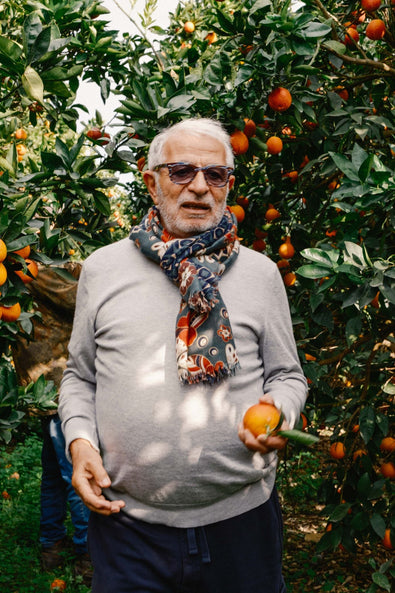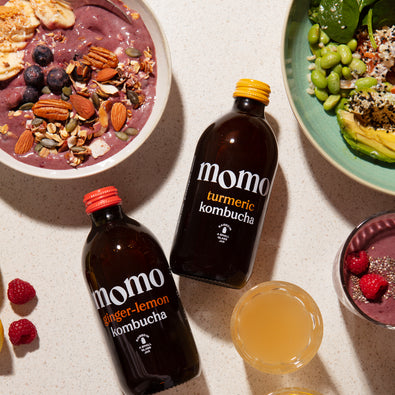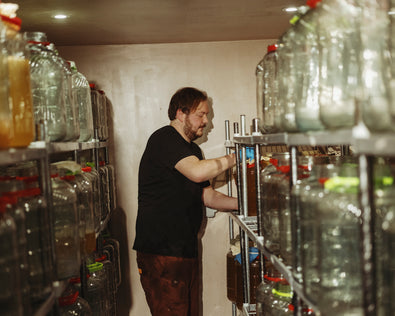Kombucha is a living, fermented tea — naturally fizzy, tangy, and made the traditional way with tea, sugar, a SCOBY (a culture of bacteria and yeast), and time.
We’ve been brewing it for years because we believe in it: the flavour, the craft, and the way it fits into a balanced, modern diet. People enjoy it for many reasons — from its refreshing taste to its place among fermented foods — and the natural compounds it retains from tea.

The goodness inside kombucha
-
Live cultures from fermentation
In unpasteurised kombucha, fermentation leaves behind live cultures and organic acids. Pasteurised kombucha is shelf-stable but won’t have the same live cultures — one reason we keep MOMO raw and refrigerated. -
Tea’s natural compounds
Kombucha contains a little caffeine and an amino acid called L-theanine from the tea it’s brewed with. Together, they’ve been studied (mostly in tea) for supporting attention and a calm sense of focus.
Green and black teas are also natural sources of polyphenols, plant compounds with antioxidant properties, and some of these carry through into kombucha. -
Naturally less sugary than most soft drinks
Fermentation uses up a portion of the sugar, so kombucha is usually less sweet than full-sugar fizzy drinks — the exact amount depends on the brand and recipe.
Real kombucha, not the shelf-stable kind
After fermentation, some kombuchas are pasteurised, finely filtered, or even brewed from concentrates. That’s fine for a long shelf life, but it means losing the live cultures. If you want the full, raw kombucha experience, look for it in the fridge and check the label.
Fermented foods and the gut
Fermented foods have been enjoyed for centuries, and modern research is starting to explore why they’re so interesting.
A Stanford study found that people who added more fermented foods to their diet for ten weeks — foods like yogurt, kefir, kimchi, and kombucha — had greater microbiome diversity and lower levels of several inflammatory markers. It’s one study, not the final word, but it’s a compelling sign of how fermented foods can interact with the body.
As Tim Spector often says, the gut microbiome is “a tiny chemical factory” — an ecosystem of microbes that thrives on variety. He’s a big advocate of aiming for 30 different plants a week, a finding that comes from the American Gut Project. Fermented foods, including kombucha, can be one part of hitting that diversity.
Focus and feel
We love that kombucha has tea’s gentle lift. The caffeine and L-theanine pairing has been shown in controlled studies on tea to support attention and calm alertness. Everyone experiences it differently, but for many, it’s one of the pleasures of drinking kombucha.
After antibiotics — the probiotic conversation
Research on probiotics and antibiotics is a lively field. Multiple meta-analyses show that specific, clinically tested probiotic strains can reduce the risk of antibiotic-associated diarrhoea when taken alongside antibiotics.
That evidence applies to defined probiotic supplements — not fermented drinks like kombucha — but it’s part of the reason why fermented foods are of interest when people think about supporting gut health more broadly.

Immunity — why it’s an exciting area
That same Stanford fermented-foods study didn’t just look at the microbiome — it also measured inflammation-related markers, which were lower in the fermented-foods group. Scientists are still unpacking what that means for immune function, but it’s an encouraging sign.
Tim Spector and other researchers point out that gut health and immune health are linked, and that a varied, plant-rich diet — with fermented foods in the mix — is a good foundation.
Our view
We don’t make kombucha because it’s trendy — we make it because we love how it tastes, how it’s made, and where it fits in a balanced diet. The science on fermented foods is still young, but what’s already emerging is enough to keep us brewing. And drinking.
References:
-
Stanford University / Cell 2021 – Fermented-food diet increased microbiome diversity, reduced inflammatory markers.
-
American Gut Project 2018 – Dietary diversity and microbiome diversity.
-
Harvard T.H. Chan – Polyphenols – Overview of antioxidant compounds in tea.
-
Cochrane Review 2017 – Probiotics for prevention of antibiotic-associated diarrhoea.
-
PubMed – Caffeine + L-theanine study – Attention and alertness in controlled settings.























